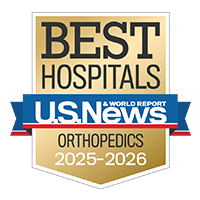Achilles Tendonitis

Overview
The Achilles tendon, which pulls up the back of the heel, is the largest tendon in the body and can withstand forces of 1,000 pounds or more. It also is the most frequently ruptured tendon. Both professional and weekend athletes suffer from Achilles tendonitis, a common overuse injury and inflammation of the tendon.
Our approach to Achilles tendonitis
To treat Achilles tendonitis, we begin with nonsurgical options, such as rest, special shoe inserts and physical therapy. If these fail to resolve the pain, we also offer surgical treatment.
Our team includes highly trained orthopedic surgeons who specialize in the ankle and foot, as well as podiatrists, physical therapists and pedorthists (specialists in modified footwear and supportive devices for the lower leg). Our goals are to relieve pain and restore mobility, so patients can return to their normal lives and the activities they enjoy. We offer doctor's appointments, medical imaging and physical therapy in one convenient location.
Awards & recognition
-

Among the top hospitals in the nation
-

Best in Northern California and No. 6 in the nation for orthopedic care
Signs & symptoms
Signs and symptoms of tendonitis include:
- Mild pain after exercise or running that gradually worsens
- A noticeable sense of sluggishness in your leg
- Episodes of diffuse or localized pain, sometimes severe, along the tendon during or a few hours after running
- Morning tenderness about an inch and a half above the point where the Achilles tendon is attached to the heel bone
- Stiffness that generally diminishes as the tendon warms up with use
- Some swelling
Diagnosis
Tendonitis is most often diagnosed by evaluating factors that indicate muscular overuse. Tendonitis often will develop when you suddenly increase your level of activity without adequate training or conditioning. This occurs frequently in occupational and recreational settings.
In addition to evaluating factors that are likely to lead to tendonitis, your doctor may use several physical examination procedures. Most tendons are near the surface of the skin and can be easily touched or pressed in order to make a diagnosis. Pressure placed directly on these tendons is likely to cause discomfort. In addition, your doctor may ask you to contract the muscle attached to the tendon, usually against resistance, to see if this causes pain.
Treatments
Conservative treatment can include resting and taking anti-inflammatory medications, using heel pads or shoe inserts designed to relieve stress on the tendon and exercises to strengthen the weak muscle group. Surgery is an option of last resort. However, if friction between the tendon and its covering sheath makes the sheath thick and fibrous, surgery to remove the fibrous tissue and repair any tears may be the best treatment option.
UCSF Health medical specialists have reviewed this information. It is for educational purposes only and is not intended to replace the advice of your doctor or other health care provider. We encourage you to discuss any questions or concerns you may have with your provider.











